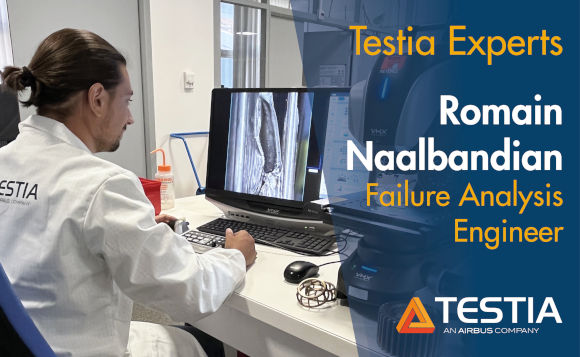In our article series “Testia Experts”, we present short interviews with our employees – the experts that really make Testia what it is. This time, Romain Naalbandian provides and overview on his job in failure analysis for Testia in Marignane.
 Hello Romain – can tell us about your job at Testia?
Hello Romain – can tell us about your job at Testia?
Sure. I’m working as a failure analysis engineer at Testia since June 2020.
I studied mechanical engineering and specialized in materials science for my master degree. My first experience in this field was in the petroleum industry as a material engineer apprentice. I worked in research & development and test center, where I started investigations on damaged seals used in offshore platform.
Then I was hired by a subcontractor of Airbus Helicopters in Marignane as a design office engineer, due to my knowledge in the mechanical field. I was on post in the Major Incident sector, where failure analysis is the core of the job but on a mechanical point of view. And, in the frame of the job and by a collaboration with the Material Laboratory, I applied for a job as a Material Engineer at Testia in order to come back to my favorite domain, and here I am.
Failure analysis engineers work with many different methods – which method is the most important for your job?
Investigations in a failure analysis process vary from case to case. You will probably use several methods in a case of a damaged steel part, and others in a case of polymer part. However, it is very important to know the part environment to better understand the degradation: What is the main purpose of a part? How does it operate and under which conditions, temperature, etc? Without these infos, the entire analytics process would remain hypothetic.
If someone asked you: “I want to become a failure analysis engineer, what do I need to do?” – what would you recommend to them?
I personally recommend to be curious. This is an important trait, because for each case we need to understand how the damage occurs, in order to apply corrective measures. Without curiosity, you could miss important findings or essential parameters to solve the problem.
Which types of failure incidents on aircraft parts do you see most often?
The most frequent incidents occur on metallic parts, especially on bearings or gears. For instance, helicopter gear boxes are a combination of mechanical parts which drive each other and it is absolutely crucial to ensure safety on these parts.
Failures like cracks are less frequent, but very insightful because aeronautical parts are designed to avoid cracks from happening. So it’s very interesting to determine their origins when they occur nonetheless. And sometimes it is possible to relate the crack characteristics to the amount of operating flight hours, by a collaboration with the stress and design departments.
What makes failure analysis an important step in the product/aircraft lifecycle? What do you like about this job?
Failure analysis is so important because it’s part of the major incident process, which allows us to better understand material behavior during aircraft operation.
What I love in this job covers several aspects. A failure analysis engineer collaborates with different departments and different specialties. This ensures that it never gets boring – also the diversity of materials, which require a mix of methods and knowledge from different areas. I also like to work closely with parts and aircrafts. This allows me to work both behind the computer and directly in the field.
Are you interested in also becoming a Testia expert? Visit our career page to find out about our current job offers!

 Hello Romain – can tell us about your job at Testia?
Hello Romain – can tell us about your job at Testia?